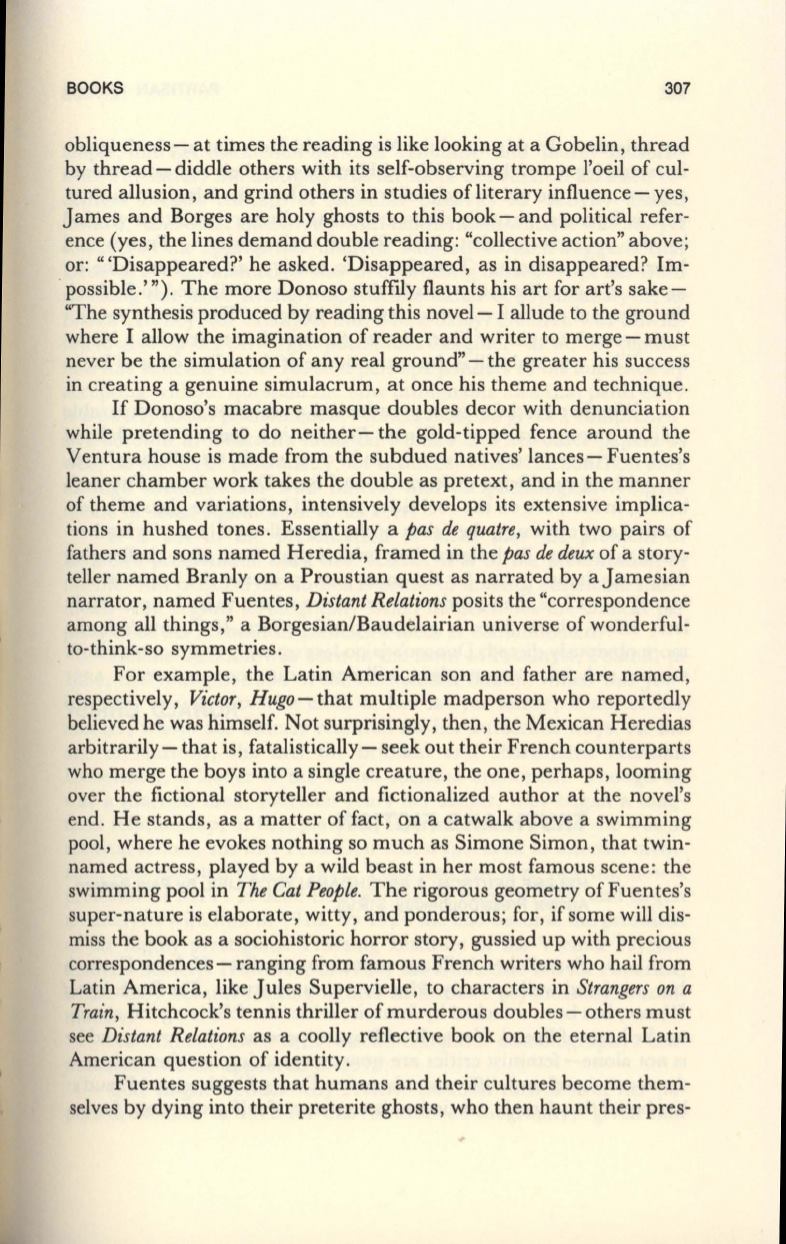
BOOKS
307
obliqueness - at times the reading is like looking at a Gobelin, thread
by thread - diddle others with its self-observing trompe l'oeil of cul–
tured allusion, and grind others in studies of literary influence - yes,
J ames and Borges are holy ghosts to this book - and political refer–
ence (yes, the lines demand double reading: "collective action" above;
or: "'Disappeared?' he asked. 'Disappeared, as in disappeared? Im-
. possible.' "). The more Donoso stuffily flaunts his art for art's sake–
"The synthesis produced by reading this novel- I allude to the ground
where I allow the imagination of reader and writer to merge - must
never be the simulation of any real ground" - the greater his success
in creating a genuine simulacrum, at once his theme and technique.
If
Donoso's macabre masque doubles decor with denunciation
while pretending to do neither- the gold-tipped fence around the
Ventura house is made from the subdued natives' lances - Fuentes's
leaner chamber work takes the double as pretext, and in the manner
of theme and variations, intensively develops its extensive implica–
tions in hushed tones. Essentially a
pas de quatre,
with two pairs of
fathers and sons named Heredia, framed in the
pas de deux
of a story–
teller named Branly on a Proustian quest as narrated by a Jamesian
narrator, named Fuentes,
Distant Relations
posits the "correspondence
among all things," a Borgesian/Baudelairian universe of wonderful–
to-think-so symmetries.
For example, the Latin American son and father are named,
respectively,
Victor, Hugo-that
multiple madperson who reportedly
believed he was himself. Not surprisingly, then, the Mexican Heredias
arbitrarily - that is, fatalistically - seek out their French counterparts
who merge the boys into a single creature, the one, perhaps, looming
over the fictional storyteller and fictionalized author at the novel's
end. He stands, as a matter of fact, on a catwalk above a swimming
pool, where he evokes nothing so much as Simone Simon, that twin–
named actress, played by a wild beast in her most famous scene: the
swimming pool in
The Cat People.
The rigorous geometry of Fuentes's
super-nature is elaborate, witty, and ponderous; for, if some will dis–
miss the book as a sociohistoric horror story, gussied up with precious
correspondences - ranging from famous French writers who hail from
Latin America, like Jules Supervielle, to characters in
Strangers on a
Train,
Hitchcock's tennis thriller of murderous doubles - others must
see
Distant Relations
as a coolly reflective book on the eternal Latin
American question of identity.
Fuentes suggests that humans and their cultures become them–
selves by dying into their preterite ghosts, who then haunt their pres-


